How to bring roses to life in a vase?

A rose is a very beautiful flower that can be kept in an ordinary vase. Like any plant, it will not be able to maintain its former attractiveness for a very long time. In such cases, do not be upset about the lost decorative flower. In this article, we will tell you how you can revive the roses in a vase.
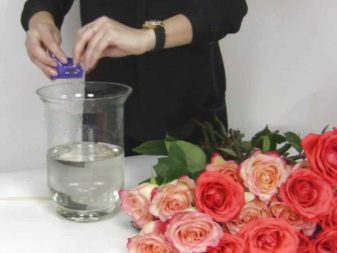

Features of caring for cut roses
Many people have come across a situation when a holiday for which beautiful flowers were purchased is postponed for a certain number of days. Because of this, the plants in a bouquet are capable of starting to lose their attractive appearance the very next day. If a person is worried that the flowers he bought will quickly wither, a refrigerating chamber and low temperature water can help in solving this problem.
After cutting or after purchasing in a specialized store, the stems will need to be sent for several hours in a cool liquid... After this, the plants will need to be wrapped in a dampened cloth, and then in a sheet of thick paper. Next, the "packed" roses are placed on the bottom shelf of the refrigerator. It is necessary to periodically check the condition of the flowers. Every day, roses must be taken out of the refrigerator, the stems must be gently rinsed in water at a comfortable temperature. It is advisable to update the cut very carefully.
Thus, you can revive and save not only gift, but also donated bouquets. The main thing is to immediately do their correct preparation for further preservation.
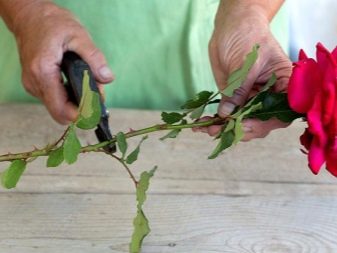

It is necessary to take into account why cut roses can wither.
- Plants wither in rooms with excessive heating. Roses shouldn't be too hot.
- If the roses in the vase are exposed to drafts, then they can also quickly wither, as well as from the heat.
- Reduced air humidity can destroy ornamental plants.
To avoid such problems, it is not recommended to place plants on a sunny windowsill, or in the immediate vicinity of heating devices installed in an apartment or a private house. The flower should be located in a space where the air temperature does not rise above +18 degrees Celsius.
As for the humidity level, it can be easily maintained by regularly spraying the leaves with a spray bottle. You can also cover the buds with a moistened plastic bag.
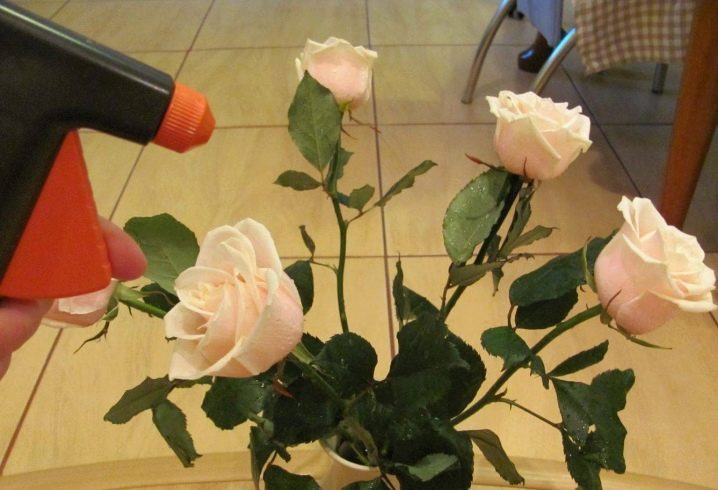
Let's see how else you can maintain the attractiveness of decorative cut flowers.
- Plants should be placed in a vase with suitable water. It must be well-established. The water should be changed periodically. In this case, the stems will require daily washing.
- It is better to remove any packaging from the bouquet, since it has ideal conditions for the appearance of pathogenic bacteria.
It should be borne in mind that self-cutting of roses is carried out at a slight angle of 45 degrees. It is recommended to use garden shears or a sharp knife when doing this. After that, the stems are carefully freed from thorns and leaf plates, so that later they do not begin to rot. Pruning roses must be carried out under running cold water so that the fibers of the plant do not dry out.

Means for revitalizing flowers
There are many different tools that can be used to effectively revitalize ornamental flowers. Let's get acquainted with the features of the use of the most popular options, which many growers turn to.
Sugar and fertilizers
You can save a beautiful rose from wilting by combining sugar with fertilizers. At the same time, we must not forget that the water in which the flowers are located must be replaced every day.
- In order for the flowers to receive all the useful trace elements and substances they need, sugar is added to the vase in an amount of 20-40 g per 1 liter of liquid. And you will also need to add a fertilizing component for flowers - 1 tablespoon will be enough.
- Instead of fertilizing ingredients, a pinch of citric acid or a teaspoon of vinegar 9% can be added to the sugared liquid in a vase.
- Underwater, trim the stems at a slight angle. As mentioned above, you will need to get rid of all the thorns and leaf plates.


It is advisable to cover the cut before placing the flower in the vase. This must be done so that air does not penetrate the fibers of the plant, since it can serve as a barrier to water.
Silver items
You can revive a rose in a vase using objects made of silver. Mucus can form where the stem is in the water. As a rule, it appears due to the multiplication of pathogenic bacteria. This fact will directly indicate that the rose begins to gradually rot. To stop this process, you should place any silver object in a vase with flowers (a regular coin or ring will do). In this way, it will be possible to stop the rotting of the stems. The flowers will then take on a fresher appearance.
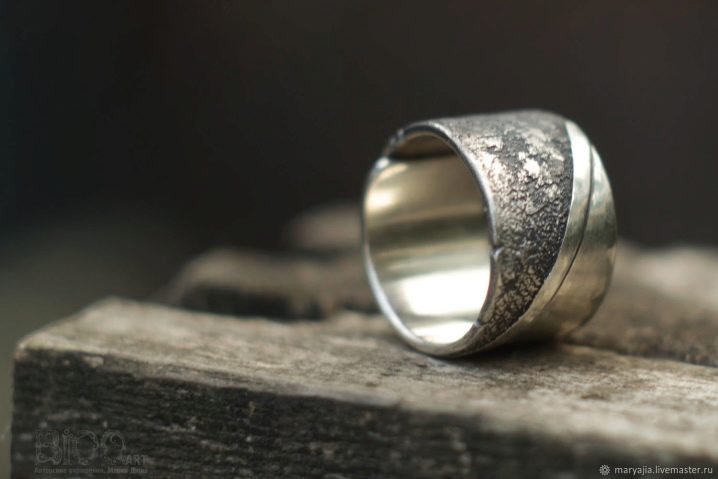
Alcohol and ammonia
You can revive and refresh wilted ornamental plants using a combination of alcohol and ammonia. These funds are perfect for a kind of "shock therapy" that brings excellent results.
Alcohol and ammonia can invigorate, as well as rid a beautiful plant in a vase of dangerous bacteria. Thanks to these means, a bouquet of roses will retain an attractive appearance for a long time.
It is enough to add just a couple of drops of ammonia and alcohol to a vase of water. They quickly disinfect the flowers, due to which the process of rotting of the stems will be successfully stopped.

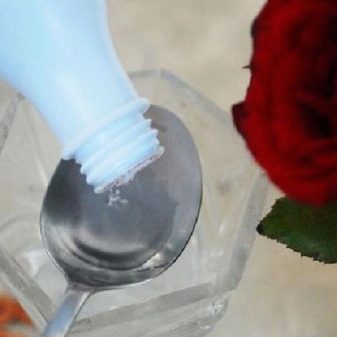
Whitening products
Everyone knows what modern whitening products are. These are chemical compounds that are used for household purposes. But not every person knows that just a few drops of bleach added to a vase of roses can protect the latter from dangerous microorganisms. Thus, it will be possible to revive wilted plants.
This type of resuscitation will be very effective if you resort to it immediately after the first signs of wilting of the buds and rotting of the stems appear.

Boiling water
If the roses in the vase have noticeably wilted, it is possible to save them at home with ordinary boiling water. Due to such a simple tool, it will be possible to extend the life of decorative flowers for another week.
You need to act simply: the stems of roses must be placed in a liquid brought to a boil. In this case, the pink buds should be wrapped in a soft cloth. The latter will protect important elements from hot steam.
It should be borne in mind that no more than 2-3 cm of stems can be dipped into boiling water. The duration of such a "saving" procedure for wilted flowers should not take more than 2-3 minutes. The part of the stem that has undergone this treatment must be carefully cut with a pruner. After that, the roses can be dipped in cold liquid.
In this "hot" way, you can effectively return the plant to a beautiful and fresh appearance.
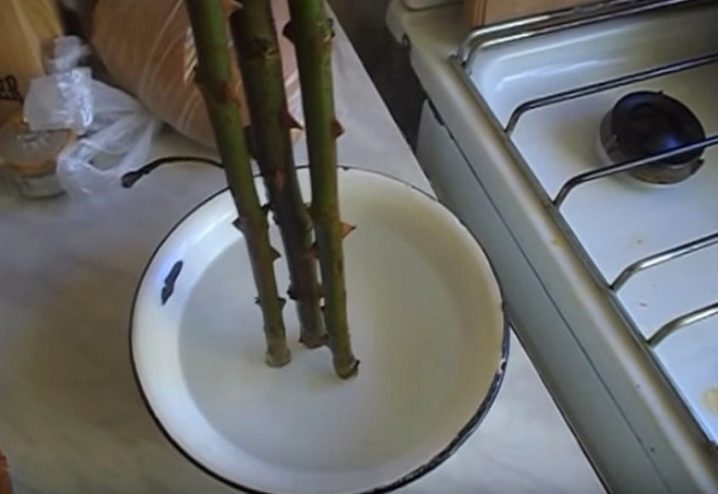
Cold water bath
It is possible to bring ornamental plants back to life using a regular bath. This procedure is very effective and popular among experienced florists.To implement it, you can use a rather high vase, inside which the stem can be completely immersed in water.
Flowers that have begun to dry out a little will need to be saturated with the necessary moisture. At the same time, a simple fluid change will not be enough. The affected area should be as extensive as possible. For this purpose, wilted flowers should be immersed in a bathtub filled with cool water. Instead, the plants can be sent to a tall vase filled with the same liquid. In the latter case, the entire stem must be in water.
Many people try to water the roses in the tub with a watering can. This method cannot be used. To achieve the desired "salutary" results, you need to fill the container with liquid, and then lower the whole flowers into it. At the same time, the buds should remain on the surface, not get wet.

If everything is done correctly, it will be possible to prolong the life of ornamental plants for a long time. If you put the buds into the water along with the stems, you can observe how they rapidly begin to darken.
When is revival impossible?
Unfortunately, there are situations in which the roses have withered, and it is simply impossible to effectively reanimate them. To try to bring a bouquet of elegant flowers back to life, you first need to fully assess the state in which it is.
- Before doing the resuscitation of roses, it is important to examine the condition of their buds. They must be closed. The buds should also be firm enough. To make sure of this, the flower must be very carefully touched. For the longest possible period, just such plants will be able to stand.
- It is also advisable to focus on the condition of the outer petals of the buds. They should not be drooping and wilted. The condition of the indicated part of ornamental plants will determine how long the rose can live without additional resuscitation actions. It is the outer petals that serve as a mechanical "shield" from many negative external factors. The external state of the petals may not be the most rosy, but they still have to perform their main functions. If the details considered began to darken, then this will be evidence of their gradual fading.
- It is necessary to take into account the degree of strength of the stem of the rose. If it has any damage or defects, it will not work to reanimate the plant.

Helpful hints and tips
Consider some useful tips on how to competently rescue roses that have begun to fade while in a vase.
- To prevent the process of damage, and restore the normal state of beautiful flowers, it is advisable for them to choose a suitable place in the home. It is not recommended to place the plant next to fruits (especially citrus fruits) or other flowers, as the rose is demanding in the neighborhood.
- So that the plant does not start to get sick and rot, it is recommended to carefully select a suitable container for it. The ideal solution would be pots or jugs made of glass with an opaque structure.
- It is highly recommended not to immerse plants in plain tap liquid. Only boiled, settled, melted and well-filtered water will do. A distilled version is also possible.
- You can sterilize the water in which the flowers are located not only with the help of silver objects. For these purposes, it is allowed to use activated carbon or potassium permanganate.
- When resuscitating colors using a whitening agent, you should not expect an instant effect. Moreover, this method is not unconditionally effective, which is why all the manipulations performed may not lead to positive results.
- When flowers are immersed in a bathtub filled with cold water, people often wet the buds as well. This cannot be done. To avoid such mistakes, you can use a piece of styrofoam.You will need to make several holes in it, and then pass the stems of flowers through them. Thus, when immersed in water, the foam will prevent the buds from getting wet.
- If it was noticed that the plants began to rot, lost their former attractiveness, and hung their heads, you can use not only ammonia, alcohol or bleach. The addition of camphor alcohol, borax or glycerin brings good results.
- Boiling water treatment also brings good results. However, it is recommended to resort to this method as a last resort, when all other methods have been tried, but it was not possible to raise and revive the roses.
- If a person is going to put a bouquet of roses in the refrigerator, then he needs to take into account the size of the bouquet itself. Situations often arise in which the latter simply cannot fit on the shelves of household appliances. Then you need to look for other ways to acclimatize flowers. You can simply put the bouquet in the coldest room of your home, placing it there for a certain number of hours.
- On the bottom of the vase, which was chosen to accommodate the beautiful roses, you can initially place a few tablets of activated carbon.
Due to such simple manipulations, it will be possible to effectively disinfect and purify the water so that the stems of roses in it do not begin to rot and do not drop the buds.





































































































The comment was sent successfully.